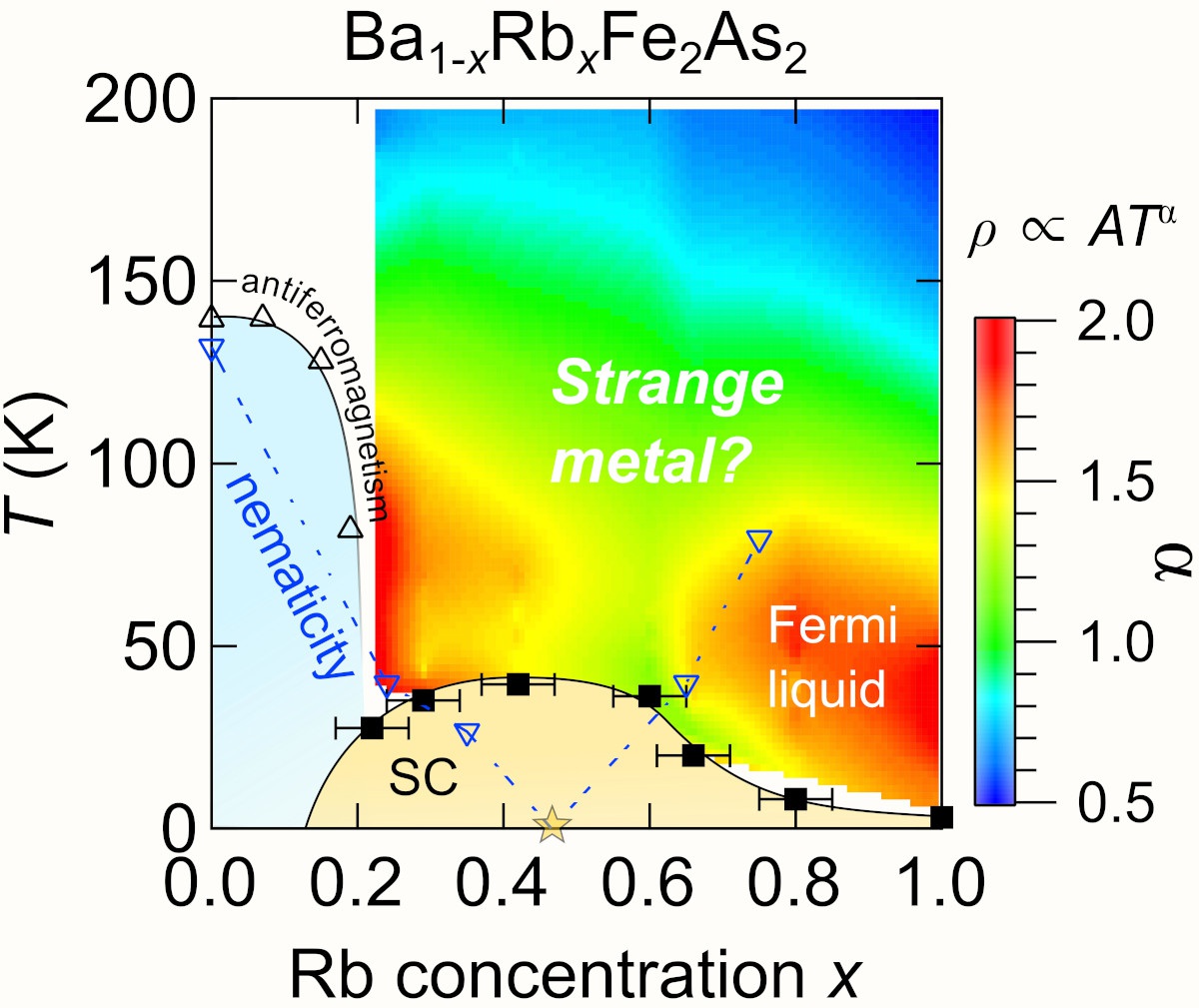Strange Metal Behavior Potentially Associated to Hidden Electronic Nematicity
© The Physical Society of Japan
This article is on
Charge Transport in Ba1-xRbxFe2As2 Single Crystals
(JPSJ Editors' Choice)
J. Phys. Soc. Jpn. 91, 104706 (2022).
Iron-based superconductor, Ba1-xRbxFe2As2, exhibits “strange metal” behavior—linear dependence of resistivity on temperature. It seems that hidden electronic nematic fluctuations play a greater role than the well-known antiferromagnetic fluctuations.

Electrical resistivity of a crystal is the measure of how easily electrons flow in it under the influence of an external electrical field. Although it is a familiar physical quantity, important insights can still be gathered by investigating it. Resistivity originates from collisions of electrons with other scatters, such as electrons and phonons. Its temperature dependence is indicative of the most common scattering event in the given temperature range. For example, according to Landau’s Fermi liquid theory, the scattering between two electrons produces resistivity, which depends quadratically on temperature. This is a consequence of the fact that electrons are fermions, and it also demonstrates that electrons carrying a current can be treated as “quasiparticles”.
However, a variety of strongly correlated metals exhibit a puzzling linear dependence of resistivity on temperature, referred to as “strange metal” behavior, inside the temperature regime in which electron-electron scattering is dominant. This challenges the “quasiparticle” explanation of charge transport. So far, in many cases, such T-linear resistivity has been observed when an antiferromagnetic transition is suppressed to zero temperature. This indicates that the intensification of spin fluctuations might be the source of the observed strange metal behavior. Indeed, several theories have been developed that corroborate this hypothesis.
This study presents systematic measurements of the electrical resistivity of single crystals of the iron-based superconductor, Ba1-xRbxFe2As2. The parent compound BaFe2As2 undergoes an antiferromagnetic transition accompanied by tetragonal-orthorhombic structural distortion, which breaks the four-fold rotational symmetry. By substituting Ba with Rb ions, antiferromagnetic structural transition is rapidly suppressed. Surprisingly, resistivity of the crystal exhibits T-linear behavior around the compositions farther from the endpoint of the antiferromagnetic order, where the spin fluctuations are thought to become strongest. However, it has been recently pointed out that although structural transition already disappears at these compositions, a critical instability remains in the electronic systems towards the four-fold rotational symmetry breaking, which may be potentially associated to the observed strange metal
behavior.
Recently, several quantum materials have been observed to exhibit an intrinsic instability of electrons towards the spontaneous rotational breaking of the underlying lattice. Based on an analogy with nematic liquid crystals, this state is called the electronic nematic state. Our conclusions suggest that fluctuations of an electronic nematic order can lead to strange metal behavior as well as antiferromagnetic fluctuations. However, further investigation of the precise form of the resistivity down to zero temperature masked by high superconducting transition temperature is required to derive more decisive conclusions. The current results serve as adequate motivation to perform such a challenging experiment.
(Written by Kousuke Ishida on behalf of all authors)
Charge Transport in Ba1-xRbxFe2As2 Single Crystals
(JPSJ Editors' Choice)
J. Phys. Soc. Jpn. 91, 104706 (2022).
Share this topic
Fields
Related Articles
-
Exploring Electronic States in BEDT-TTF Organic Superconductors
Superconductivity
Electronic transport in condensed matter
Magnetic properties in condensed matter
2024-4-24
This review, published in the Journal of the Physical Society of Japan, provides a comprehensive summary of the electronic states observed in BEDT-TTF type organic superconductors, including metal-insulator transitions, Mottness transitions, non-Fermi liquids, quantum spin liquids, and Bose-Einstein condensation.
-
Conversion of Chiral Phonons into Magnons in Magnets
Electronic transport in condensed matter
2024-4-1
A new phenomenon involving the conversion of chiral phonons into magnons is theoretically predicted. The effective magnetic field induced by chiral phonons causes a change in the spin magnetization of magnets.
-
Variety of Mechanically Induced Spin Currents in Rashba Systems
Electronic transport in condensed matter
Magnetic properties in condensed matter
Structure and mechanical and thermal properties in condensed matter
2024-3-22
Various types of spin currents, including unconventional types, are generated in Rashba spin-orbit coupled systems by dynamic lattice distortions associated with, for example, surface acoustic waves.
-
What Determines the Sign of Spin Current? ~ Theoretical Study of Spin Seebeck Effect in Antiferromagnetic Insulators
Electronic transport in condensed matter
2024-3-18
We developed a microscopic theory for the spin Seebeck effect in antiferromagnets, that explains the sign reversal of the spin current at the spin-flop transition point and describes the sorts of dominant carriers.
-
Chiral Anomalies in Organic Dirac Semimetals
Electronic transport in condensed matter
2024-2-5
A three-dimensional massless Dirac fermion system exhibiting broken chiral symmetry was successfully realized in organic conductor α-(BEDT-TTF)2I3 under high pressures. Our study detected the chiral anomaly-induced negative magnetoresistance and planar Hall effects and opened new avenues for further advancements in the field.
